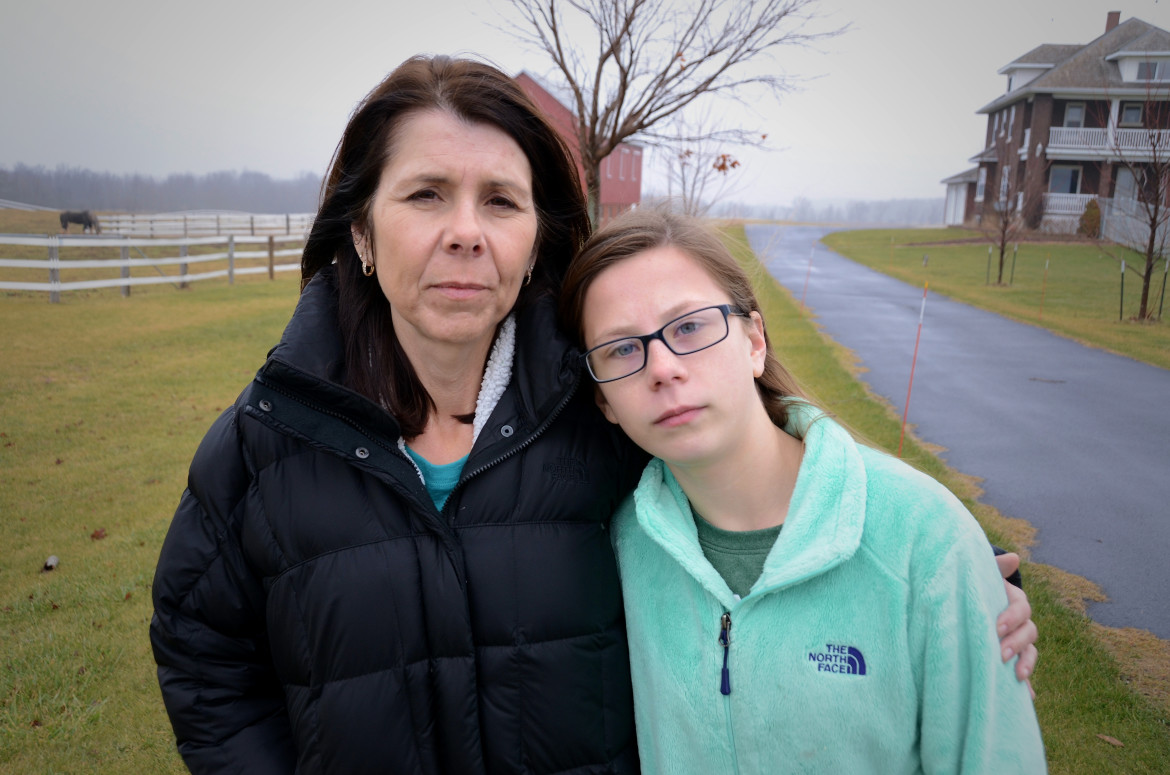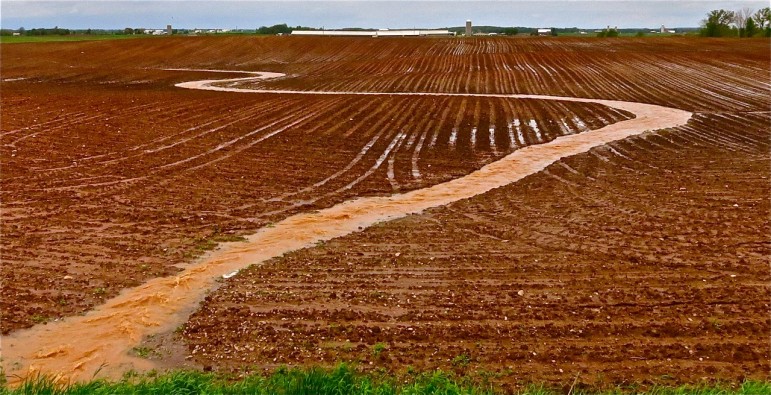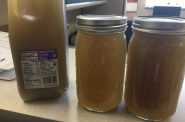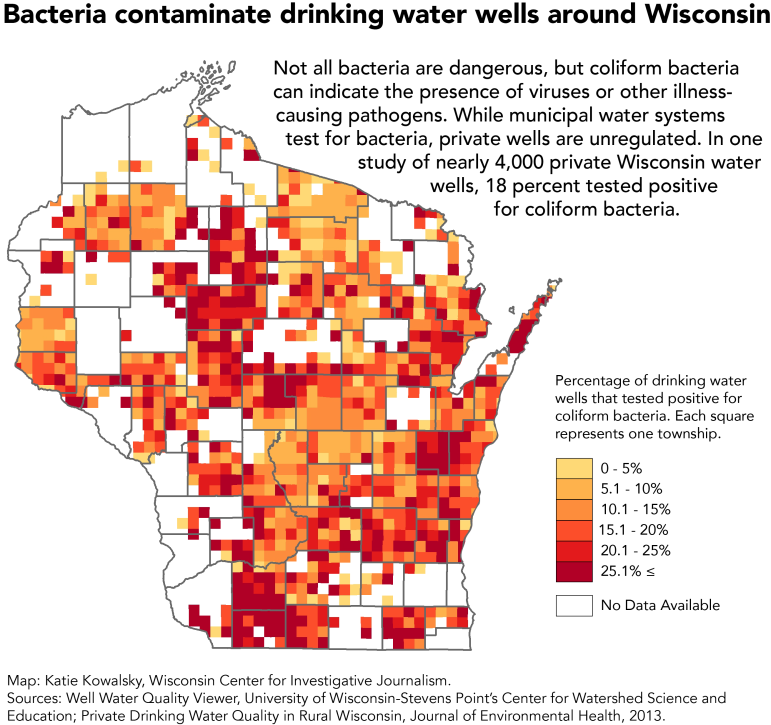Bacteria Taints State’s Drinking Water
169,00 households served by private wells that tested positive for coliform bacteria.

About 12 years ago, Samantha Treml, right, then six months old, fell ill after being bathed in well water tainted by manure spread on a nearby frozen farm field. The Tremls moved from their Kewaunee County home after that incident, saying they no longer trusted the quality of their water. Recent tests in Kewaunee County funded by the state Department of Natural Resources found 34 percent of wells had unsafe levels of coliform, E. coli or nitrate. Photo by Tad Dukehart for the Wisconsin Center for Investigative Journalism.
Late on a winter night in 2004 in Kewaunee County, six-month-old Samantha Treml was rushed to an emergency room, violently ill from bathing in water poisoned by manure spread on a nearby frozen field that seeped into the home’s private well. The rest of her family got sick, too.
In 2014, seven people visiting Door County were sickened after manure from a large farm made its way into a home’s private water well.
In 2015, Kewaunee County Board member Chuck Wagner discovered that the new $10,000 well he was forced to install two years earlier was again contaminated with viruses and cow manure. Wagner and his wife now use a reverse osmosis system to filter the water before drinking or cooking while they contemplate whether to dig a second new well.
And this year, the Algoma School District is offering free water to residents whose wells are contaminated, although that source has been shut down a few times after vandals damaged the dispenser. In early March, a group of local residents asked the U.S. Environmental Protection Agency to provide emergency water for Kewaunee County residents with contaminated drinking water.
“It’s astonishing, the number of people who can’t use their drinking water,” said Algoma School District Superintendent Nick Cochart, whose own well is polluted.
Between 2007 and 2010, an estimated 18 percent of 3,868 private wells in Wisconsin tested positive for coliform bacteria — an indicator of disease-causing bacteria, viruses or parasites — according to a 2013study by researchers with the state Department of Health Services. That translates into as many as 169,200 of the 940,000 Wisconsin households served by private wells exposed to disease-causing pathogens.
The problem also plagues municipal water systems where coliform bacteria accounts for most of the violations of health standards recorded each year. The 2014 Department of Natural Resources drinking water report on the state’s public water systems found 3.7 percent, or 420 of the 11,420 systems, had detectable levels of coliform.
The report said those 420 systems serve about 92,290 people. Most of the violations, 351, were in small public water systems serving motels, restaurants, churches and campgrounds.
Contamination by pathogens is of special concern because unlike pollution by metals or chemicals, pathogens can sicken people after just a single exposure. The gastrointestinal illnesses that result can be life-threatening for people with weakened immune systems such as the sick, elderly and infants.
Pathogens such as bacteria, viruses and parasites are the most frequent causes of illnesses in private water systems, according to the U.S. Centers for Disease Control and Prevention.
Whether it was manure spread irresponsibly on a frozen field, a septic system compromised by pollution-prone geology or untreated municipal drinking water, incidents of pathogens in drinking water in Wisconsin have revealed weaknesses in government oversight of this most basic and necessary resource, the Wisconsin Center for Investigative Journalism found.
Committees formed as a result of contamination in Kewaunee County recently proposed steps to be taken by the DNR, state lawmakers and others to better protect Wisconsin’s drinking water from agricultural pollution.
These work groups, composed of farmers and residents and federal, state and local officials, were formed after Kewaunee County residents petitioned the EPA in 2014 for help with the county’s water problems.
The recommendations included $300,000 to provide “reparations,” including emergency safe water supplies, treatment systems and new wells for households whose drinking water has been contaminated by livestock manure. Other proposals included voluntary restrictions on spreading manure on sensitive lands, additional staff, heightened oversight and more timely response and enforcement to complaints by the DNR.

Water runs off a field near the border between Kewaunee and Brown counties. The counties, parts of which have geology particularly susceptible to groundwater contamination, are home to several large dairy farms. Dale Goodner of Algoma, who took this photo in spring 2013, says it illustrates “how easily soil and manure find their way into our streams and rivers.” Photo courtesy of Dale Goodner.
George Althoff, DNR spokesman, said the agency is “actively working on formulating short-term and long-term plans to address water quality issues in Kewaunee County.” He added that “this has been and is a priority for the agency.”
“I think we’re making progress,” agreed Russ Rasmussen, a DNR natural resource manager who is coordinating the Kewaunee County effort.
But some residents and others remain skeptical that the DNR will take meaningful action, and they criticize the agency for taking too long to address what some are calling a crisis.
In March, Midwest Environmental Advocates, the public interest law firm that petitioned the EPA on behalf of Kewaunee County residents, shot off another letter to the agency slamming the lack of progress, saying there still has been no “direct action to provide local residents with clean, reliable drinking water.”
The delayed response to the region’s drinking water problems also has attracted the attention of U.S. Sen. Tammy Baldwin. Baldwin in March sent a letter to the heads of the U.S. Department of Agriculture and the EPA requesting “immediate attention to this urgent public health issue and your assistance in making safe drinking water options available as soon as possible.”
Tainted Water
-
Fecal Microbes In 60% of Sampled Wells
 Jun 12th, 2017 by Coburn Dukehart
Jun 12th, 2017 by Coburn Dukehart
-
State’s Failures On Lead Pipes
 Jan 15th, 2017 by Cara Lombardo and Dee J. Hall
Jan 15th, 2017 by Cara Lombardo and Dee J. Hall
-
Lax Rules Expose Kids To Lead-Tainted Water
 Dec 19th, 2016 by Cara Lombardo and Dee J. Hall
Dec 19th, 2016 by Cara Lombardo and Dee J. Hall


















My only problem with this article is the headline… As the DNR graph points out, most bacteria isn’t problematic. And you better believe city water – ALL water, for that matter – is “tainted” with bacteria of some form. A more appropriate title may have included the word ‘dangerous’ or a synonym.
Otherwise, sucks for the well drinkers – a majority of wisconsinites. Hopefully some of the outlined solutions can help with thr coliform problem.
Thank god we have a state DNR with scientists that can regulate the huge agribusinesses where….Oh, wait, what’s that? Oops.
Wisconsin is fast becoming an unsafe place to live. We have bad water wells in Kewaunee County and also wells in Racine County polluted by the use of coal ash for back fill around buildings and roadways. The DNR does not seem to have the personal or the interest to identify and fix the problems. In the South West quarter of Wisconsin we are mining the silica sand that is used in the frack mining industry. The levels of dust in the air are not controlled well and the silica material is a health hazard. Lakes and rivers and water wells are drying up because of high capacity wells that are used in the farming and mining industry.
Yes there have always been problems but these things are new and accelerating in number.